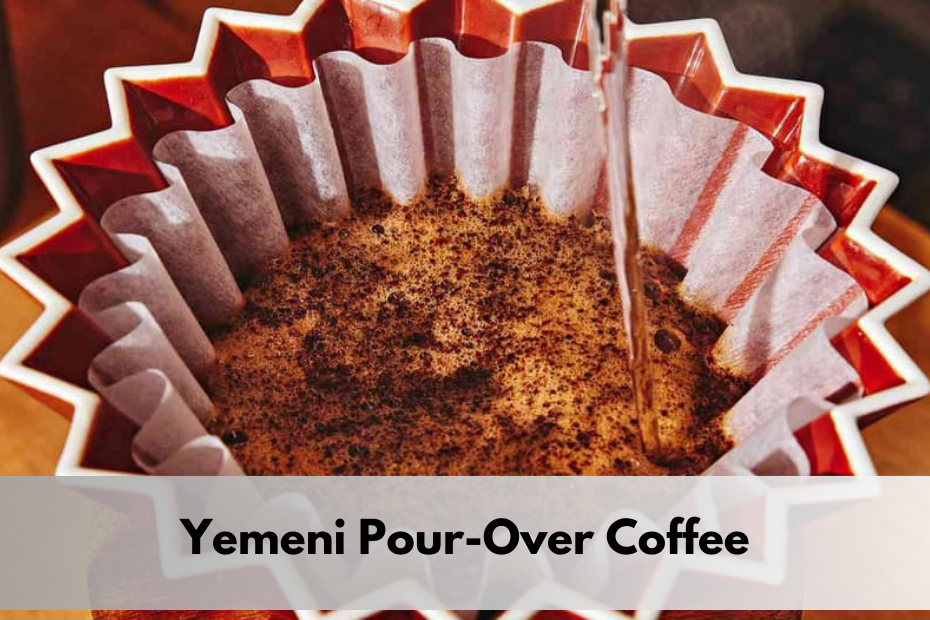Yemen, a land whispered through myths of ancient coffee kingdoms, boasts a unique and time-honored coffee culture. Yemeni coffee beans, cradled at high altitudes and meticulously hand-processed, brim with complex flavors and an enticing aroma. The Yemeni pour-over method, known as “Buna,” is a slow, meditative process that goes beyond just brewing a cup; it’s a cultural immersion for the senses. This in-depth exploration delves into the history, brewing process, and variations of Yemeni pour-over coffee, offering a comprehensive guide for coffee enthusiasts worldwide.
Ingredients: A Gathering of Yemeni Treasures

To embark on your Yemeni pour-over journey, you’ll need a few key ingredients:
- Yemeni Coffee Beans (20-25 grams): Seek out high-quality Yemeni beans like Sanaani, Habshi, or Yemeni Mocha. These beans are often naturally processed and sun-dried, known for their bold flavors with hints of fruit, chocolate, and spice. Freshness is crucial, so buy whole beans and grind them just before brewing.
- Water (200ml): Use filtered or spring water for the best taste. Avoid using tap water with a strong mineral content, as it can affect the coffee’s flavor profile.
- Spices (Optional): Cardamom pods or cloves are traditionally added to the water for an aromatic touch, evoking the spice caravans that once traversed Yemen’s ancient routes. Experiment with other spices like ginger or a pinch of nutmeg for a personalized twist.
- Sweetener (Optional): Sugar or honey are commonly used to balance the strong coffee flavors. Adjust the amount to your preference.
- Dallah (Optional): This traditional Yemeni coffeepot, typically crafted from brass or copper, features a long, slender spout and a small base. While a dallah is ideal for an authentic experience, a heat-resistant glass carafe can be substituted.
- Grinder: A burr grinder is highly recommended to achieve a very fine, almost powdery consistency, crucial for the Yemeni pour-over method.
- Filters: Unbleached paper filters are commonly used. Some may choose a traditional “finjan” filter, a small cloth strainer placed directly over the cup.
- Finjans (Optional): These small, handleless cups are traditionally used for serving Yemeni coffee. Any small cup will work in a pinch.
The Yemeni Pour-Over Ceremony (Buna): A Step-by-Step Guide
-
The Roast: While Yemeni coffee is traditionally roasted over hot coals in a rotating drum, most home coffee enthusiasts will rely on pre-roasted beans. Look for a medium to dark roast to best capture the Yemeni profile.
-
Grinding the Beans: Freshness is paramount. Grind the coffee beans immediately before brewing, aiming for a very fine, almost powdery consistency. If using a scale, a good starting point is a 1:10 coffee-to-water ratio (e.g., 20 grams of coffee for 200 ml of water).
-
Preparing the Dallah: Fill the dallah (or carafe) with fresh, cold water. If using spices, add them to the water at this stage. Traditionally, cardamom pods or cloves are used. Heat the water over low heat.
-
Adding the Coffee Grounds: Gently add the ground coffee to the hot water in the dallah. Stir with reverence, incorporating the grounds without disturbing the sediment at the bottom.
-
The First Brew: A Gentle Simmer Place the dallah over low heat and bring the water to a simmer. Do not let the coffee boil. Patience is key here. Once simmering, remove the dallah from heat and allow the coffee to settle for 2-3 minutes, letting the flavors bloom.
-
The Second Brew: Patience Rewarded Return the dallah to low heat and bring back to a simmer. Again, remove from heat and allow to settle for another 2-3 minutes. This step helps extract more flavor and create a thicker consistency, characteristic of Yemeni coffee.
-
Serving: A Moment of Cultural Connection Traditionally, Yemeni coffee is served in small, handleless cups called “finjans.” If you don’t have finjans, any small cup will work. Pour the coffee slowly and carefully, allowing the sediment to settle at the bottom of the dallah. Offer dates or other sweet treats to complement the strong coffee flavors, echoing the Arabian tradition of pairing sweet and bitter.
(FAQ)
-
What are the differences between Yemeni pour-over and classic pour-over methods?
- Grind: Yemeni pour-over uses a very fine, almost powdery grind, unlike the medium grind typical of classic pour-over.
- Water Temperature: Yemeni coffee is brewed with simmering water, not boiling water, which can extract bitterness.
- Multiple Brews: The traditional Yemeni method involves two simmering rounds to extract more flavor and create a thicker consistency.
-
Can I substitute the dallah for another brewing vessel?
- Yes, a heat-resistant glass carafe can be used in place of a dallah. However, the dallah’s design helps control the brewing temperature and adds a touch of authenticity.
-
What if I don’t have a burr grinder?
- While a burr grinder is ideal for achieving the fine grind, a blade grinder can work in a pinch. Be mindful of over-grinding, which can lead to bitterness.
-
How much coffee should I use?
- A good starting point is a 1:10 coffee-to-water ratio. This means using 20 grams of coffee for 200ml of water. You can adjust this ratio based on your desired strength.
-
Can I add milk to Yemeni coffee?
- Traditionally, Yemeni coffee is enjoyed black. However, you can certainly add a splash of steamed milk for a creamier experience. This variation is known as “Bunna bil-ban.”
Beyond the Basics: Variations on Yemeni Pour-Over

The beauty of Yemeni coffee lies in its adaptability. Here are some variations to explore:
- Sweetened Coffee (Qahwa mazbuta): Add sugar or honey to taste during the brewing process.
- Spiced Coffee (Qahwa hawash): Experiment with spices like ginger, cinnamon, cardamom, or a pinch of cloves for a unique twist. Add the spices directly to the water in the dallah before brewing.
- Milk Coffee (Bunna bil-ban): As mentioned earlier, add a splash of steamed milk for a creamier coffee.
Conclusion
Yemeni pour-over coffee offers a unique and flavorful brewing experience. By following these guidelines and exploring the variations, you can embark on a sensory journey to the heart of Yemeni coffee culture. Remember, patience is key! Take your time, savor the aroma, and enjoy the rich flavors of this traditional brewing method.








